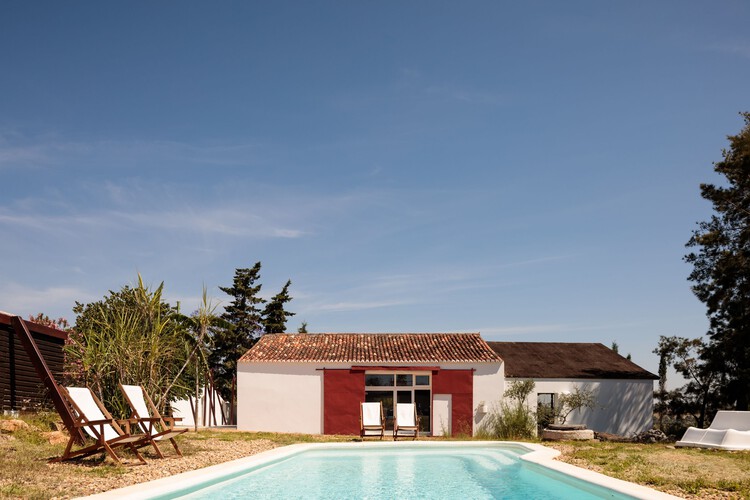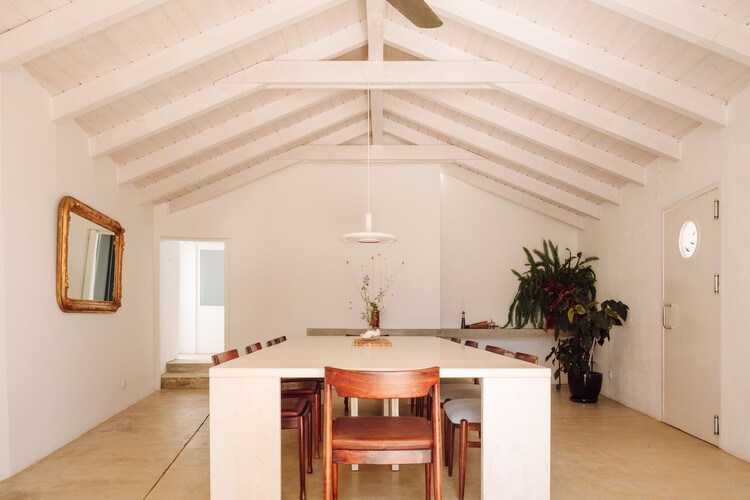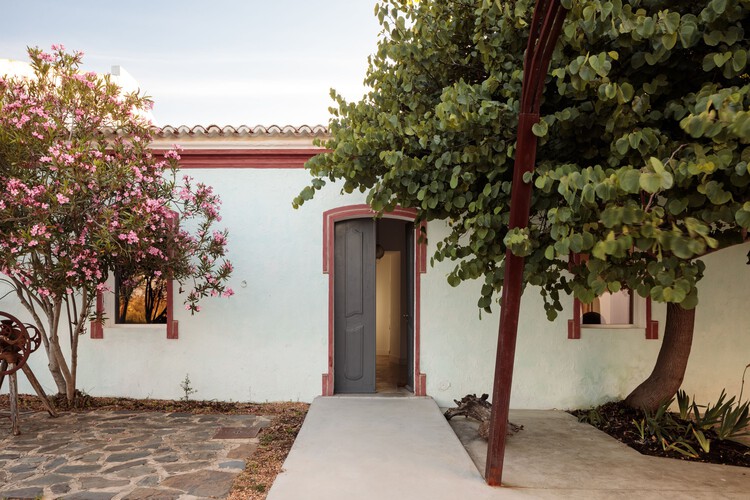
-
Architects: Ressano Garcia
- Area: 12809 ft²
- Year: 2018
-
Photographs:Francisco Nogueira
-
Manufacturers: Amorim, Revigres, Roca, Topciment, Viega

Text description provided by the architects. This project aims to recover the set of ruins on the agricultural property of Fazenda de São Bartolomeu.

The Existing Situation
The whole is more like a small village where each building is a distinct part of its neighbor. A rich variety of typologies appears and yet there is a profound uniformity in the whole. The old facilities dedicated to agriculture were built and adapted according to new needs. The replacement of people by the machine brought changes in use.


The concept
It is the walls that tell us the history of the place. There are different layers of intervention and it is always possible to read backwards, in time, because the past is transparent. The walls now in ruins were erected using different building technologies. They are adobe, stone, manufactured brick and industrial brick. There are also concrete, “tout venant” walls, partition walls and cement bricks.

In this varied range of solutions, there are different reports, as in a text about local construction techniques and materials, through the centuries, their lives, their knowledge and their culture.

The materials used in the new intervention are deliberately associated with the contemporary moment. It is intended, on the one hand, to take advantage of the advantages and quality of current construction materials and, on the other hand, to prolong the idea of transparency in which it is possible to read the history of the place, deciphering the narrative inscribed on the walls. The project seeks, above all, to write anew about the previous writings, contributing to the sedimentation of what is its identity.

The program
Faced with the cluster of abandoned agricultural buildings, today completely stopped, we are asked a question. What to do? How to act in the face of these and many other old installations destined for agricultural uses. Today in disuse, the European Community imposes minimum productions that are far from the capabilities of Castro Marim's climate. Throughout the year, according to statistics, there are about thirty days of rain, the least rainy region in the entire country. This is the main reason for the influx of elderly tourism to Monte Gordo and Tavira throughout the year. Tourists interested in cultural and artistic aspects, unlike the hottest summer months where there is another type of tourism.

The conditions for a good turnout of the public are created, on the other hand the owners are not farmers as their ancestors were, they are people linked to the culture. Intellectuals who have promoted a series of cultural activities at the Farm and who want to recover a space so that an increasing number of events can take place. The program aims to create an alternative to the August tourism that characterizes the Algarve. These are activities that take place throughout the year, taking advantage of the good weather conditions and offering an alternative of cultural interest.




The aim is to create a space for culture. A space that supports the cultural manifestations of various artists and promotes manifestations of various cultures, a meeting of cultures. The Culture Company. A place that serves tourism and the local community by developing a wide range of initiatives. The culture manifested in its most varied expressions, which includes local gastronomy, dance meetings, an antique furniture restoration workshop, exhibitions of pieces by contemporary artists, seminars and meetings where it will also be necessary to host artists, lecturers. Each space corresponds to a certain function, however our objective for the multi-purpose space both outdoors (250m2) and indoors (180m2) is to create a truly versatile space oriented to receive both a play and a conference. or even the town's sports group party, among many other possibilities.

We divided the set into three groups. The first one, where the car park and reception are located, and which houses the antique furniture restoration workshop, in the old dairy building. This is the first group, a nucleus of two buildings located between the old sheepfold and “Monte de Cima”. The sheep is the second group and is located to the east of the third group that constitutes the most complex agglomeration of constructions, it is the biggest nucleus of the project.


The ovil building, due to the spatial characteristics of its architecture, is the ideal place to promote local gastronomy. Called Bar, it is a cool place in summer and sunny in winter where you can hear the sea on the days of the east. It is a grandiose space where visitors can rest and drink something while they wait or even try the most traditional local cuisine, variations of tuna. It can be raw, smoked, grilled, or dried, in short, a whole tradition almost disappearing but from which we still found a local and resistant cook who will participate in the cultural center project.

Finally, the third group where the large spaces designated by multi-use will serve for the activities described above. We intend, above all, to generate a dynamic space where events succeed and complete each other. We defined for this third core of the project three main areas, the multi-purpose space, the exhibition area and spaces for the studio, and also an area for accommodation.

The mill, the garage and the square are spaces clearly designed for a greater number of people to occupy. We call this concentration the multi-purpose space that, together with the common square, suggests a space of great functional capacity.

The old barn, the adjacent walled corral and the warehouse are very closed buildings with very few openings, facing inwards, where the best conditions are created for a workshop and exhibition area, the cultural space. The resident artists have priority and exhibit in their own work places, that is, in their studios.

The third zone is defined by the set of houses with a housing vocation, it has more cut-out spaces. In these modules there are old infrastructures, the kitchens for example, which must be preserved. The spatial structure of these constructions suggests destining these spaces for accommodation.
The proposal
The architectural project is based on respecting this idea of transparency and the possibility of reading backwards in time, however, the new needs require some interventions. In the existing buildings, two transformation cores are proposed, an interior courtyard and an exterior courtyard.

The inner courtyard consists of a subtraction on the western side of the buildings intended for housing. This intervention aims to extend the existing patio whose light and ventilation work very well. The extension will bring more light and better ventilation to the complex, as it is currently a dark and unventilated interior.

The exterior patio is located in the southern part of the complex and aims to define the limits of the space that is currently passing through. The outer courtyard is defined by vertical elements that fill it. The space is designed from within and not from its limit as is common, it is these vertical elements that define the patio instead of the walls.

































